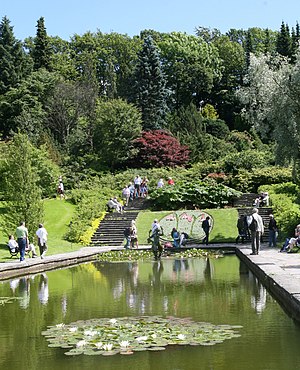Gothenburg Botanical Garden
| Gothenburg Botanical Garden | |
|---|---|

The mirror pond at the entrance of Gothenburg Botanical Garden
|
|
| Type | Botanical |
| Location | Gothenburg, Sweden |
| Coordinates | 57°40′51″N 11°57′17″E / 57.6808°N 11.9546°ECoordinates: 57°40′51″N 11°57′17″E / 57.6808°N 11.9546°E |
| Area | 175 hectares (430 acres) |
| Opened | 1923 |
| Owned by | Västra Götaland Regional Council |
| Visitors | more than 500,000 per year |
| Status | Open year round |
| Species | > 16,000 |
| Website | www |
The Gothenburg Botanical Garden (Swedish: Göteborgs botaniska trädgård) is located in Gothenburg, Sweden, and is one of the larger botanical gardens in Europe.
The Gothenburg Botanical Garden is situated in a formerly completely rural area, where earlier a great country estate named Stora Änggården was located. The Garden was initially funded by a donation from the Charles Felix Lindberg Foundation, in special memory of Lindberg himself. Lindberg was a Swedish businessman and donor, who died in 1909.
The Gothenburg City Council took the initiative to the Botanical Garden in 1912. The decision was finally taken in 1915 and work started in 1916. The park was opened to the public in 1919 (the Woodlands) and in 1923 (the cultivated areas). It was first planned as ”a field for experimentation and biological demonstrations, and a nature park”. Stora Änggården was built in 1812 and renovated under the supervision of the architect Sigfrid Ericson in 1919 and is now used as staff residence.
The Gothenburg Botanical Garden was inaugurated in 1923 when Gothenburg celebrated its 300th anniversary.
One of the prominent botanists who created the garden was Carl Skottsberg, who made several research trips around the globe to collect the rare plants of the garden.He was appointed as the first director, and worked from 1919 until 1948. The road outside the Main Entrance is named after him (Carl Skotttsbergs gata).
Donations from many sources have played a vital role in the financing of the garden, including financing the construction of the Office Building. The Office Building was designed by the Swedish architect Arvid Bjerke and completed in 1926. A wing was added in 1936 to house the herbarium.
Land was donated by the City and by private persons. An adjacent plot of land was donated by the City to Gothenburg University for the construction of the Department of Biology and Environmental Sciences buildings, to the right seen from the Main Entrance. They were designed by the architects Stig Hansson and Walter Kiessling and completed in 1971. In 1975 The Woodlands containing the arboretum with a collection of exotic trees were declared as a Nature reserve in 1975 and was named Änggårdsbergen.
...
Wikipedia
